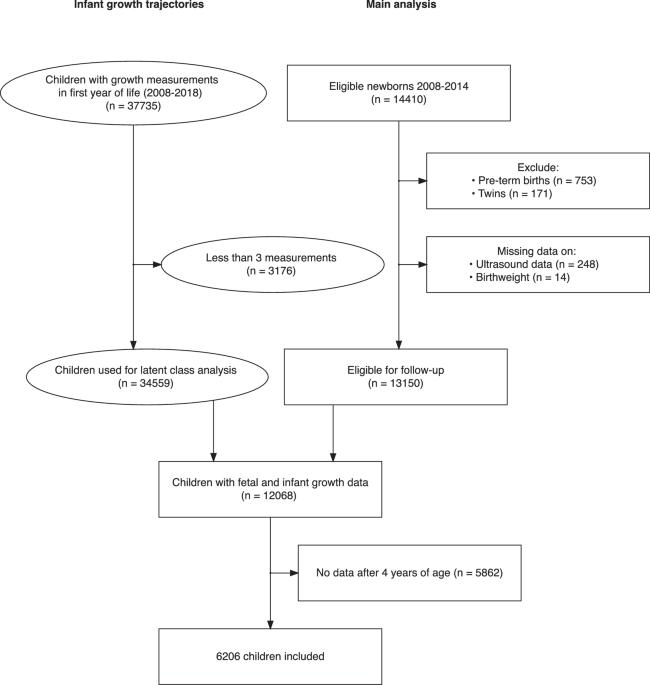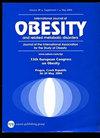The association of fetal growth rate and growth in first year of life with childhood overweight: a cohort study
IF 4.2
2区 医学
Q1 ENDOCRINOLOGY & METABOLISM
引用次数: 0
Abstract
There is an increasing focus on the first 1000 days from conception to two years of age as a period of importance for future weight. We aimed to describe the interaction between fetal and infant growth and their association with and ability to predict childhood overweight. We used routinely collected fetal growth data from Aarhus University Hospital and child growth data from Aarhus Municipality, 2008–2018. The outcome was overweight at age 5–9 years. The fetal growth rates at weeks 28 and 34 were extracted from individual trajectories using mixed models. We identified patterns of infant BMI Z-score growth using latent class analysis and estimated odds ratios of overweight at age 5–9 years dependent on fetal and infant growth. Predictive capabilities were assessed by comparing areas under the ROC-curves (AUCROC) of the prediction models. In 6206 children, we identified three infancy growth patterns: average, accelerated, and decelerated growth. We found 1.09 (95% CI: 1.06–1.12) greater odds of being overweight for every 10 g/week increase in fetal growth rate at week 34. Compared with average growth, accelerated infant growth was associated with 1.52 (95% CI: 1.20–1.90) greater odds of overweight. Combining fetal and infant growth, children with average fetal growth and accelerated infant growth had 1.96 (95% CI: 1.41–2.73) greater odds of overweight. Fast fetal growth with decelerated infant growth was not associated with being overweight (OR: 0.79 (95% CI: 0.63–0.98)), showing that infant growth modified the association between fetal growth and overweight. When fetal growth was added to a prediction model containing known risk factors, the AUCROC remained unchanged but infant growth improved the predictive capability (AUCROC difference: 0.04 (95% CI: 0.03–0.06)). Fetal and infant growth were independently associated with overweight, but distinct combinations of fetal and infant growth showed marked differences in risk. Infant, but not fetal, growth improved a prediction model containing known confounders.

胎儿生长速度和出生后第一年的生长与儿童超重的关系:一项队列研究。
背景:人们越来越关注从受孕到两岁的头 1000 天对未来体重的影响。我们的目的是描述胎儿和婴儿生长之间的相互作用及其与儿童超重的关联和预测能力:我们使用了奥胡斯大学医院定期收集的胎儿生长数据和奥胡斯市政府2008-2018年的儿童生长数据。结果是5-9岁儿童超重。使用混合模型从个体轨迹中提取了第 28 周和第 34 周的胎儿生长率。我们利用潜类分析确定了婴儿体重指数 Z 值的增长模式,并根据胎儿和婴儿的生长情况估算了 5-9 岁时超重的几率比率。通过比较预测模型的 ROC 曲线下面积(AUCROC)来评估预测能力:在 6206 名儿童中,我们发现了三种婴儿期生长模式:平均生长模式、加速生长模式和减速生长模式。我们发现,在第 34 周时,胎儿生长速度每增加 10 克/周,超重几率就会增加 1.09(95% CI:1.06-1.12)。与平均生长速度相比,婴儿加速生长与 1.52(95% CI:1.20-1.90)的超重几率有关。结合胎儿和婴儿的生长情况,胎儿生长速度一般而婴儿生长速度加快的儿童超重几率要比胎儿生长速度一般而婴儿生长速度加快的儿童高 1.96(95% CI:1.41-2.73)。胎儿生长快而婴儿生长减速与超重无关(OR:0.79(95% CI:0.63-0.98)),这表明婴儿生长改变了胎儿生长与超重之间的关联。当将胎儿生长添加到包含已知风险因素的预测模型中时,AUCROC 保持不变,但婴儿生长提高了预测能力(AUCROC 差异:0.04 (95% CI: 0.63-0.98)结论:结论:胎儿和婴儿的生长发育与超重有独立的关联,但胎儿和婴儿生长发育的不同组合显示出明显的风险差异。婴儿而非胎儿的生长改善了包含已知混杂因素的预测模型。
本文章由计算机程序翻译,如有差异,请以英文原文为准。
求助全文
约1分钟内获得全文
求助全文
来源期刊

International Journal of Obesity
医学-内分泌学与代谢
CiteScore
10.00
自引率
2.00%
发文量
221
审稿时长
3 months
期刊介绍:
The International Journal of Obesity is a multi-disciplinary forum for research describing basic, clinical and applied studies in biochemistry, physiology, genetics and nutrition, molecular, metabolic, psychological and epidemiological aspects of obesity and related disorders.
We publish a range of content types including original research articles, technical reports, reviews, correspondence and brief communications that elaborate on significant advances in the field and cover topical issues.
 求助内容:
求助内容: 应助结果提醒方式:
应助结果提醒方式:


